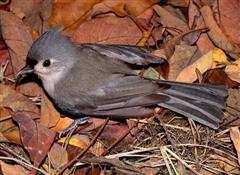Titmouse - Tufted
Scientific Name: Baeolophus bicolor
Fri, 4th July, 2025 - 5:28 am GMT
Sponsor Ads:

Alternative Name
Scientific Name: Baeolophus bicolorBasic Info
The Tufted Titmouse is short, like other small songbirds, with an equally short bill and a gray and white body. Gray will make up the upper portions of the body, with white making up most of the bottom. The Tufted Titmouse has a dark forehead, with rust-colored flanks. Both males and females are colored in this fashion.
Health
In the summertime, these birds will happily pick at the insects in your backyard; they like spiders, small insects and caterpillars, so if you have a caterpillar infestation, you can count on the Tufted Titmouse to handle it for you. Leaving out a feeder with sunflower seeds in it would benefit this bird greatly during the wintertime. As always, make sure you have a birdbath out so the Tufted Titmouse can keep itself clean. Breeding The Tufted Titmouse will begin its breeding season in late April, ending it in July. The female of the species will lay a clutch of eggs, typically anywhere from three to nine, the eggs being a white in color with some purplish-brown spots. These eggs will incubate for around 13 days, with the baby Titmice being unable to open their eyes until 4 days after hatching. Both mates help feed the chicks, until about 2 weeks have passed, when they will leave the nest.Habitat
N/ABehavior
The Tufted Titmouse, a little songbird common to the Eastern United States, is an adorable and friendly bird to have visiting in your backyard. They are excellent at pest control, feeding primarily on insects in the summer and fruit in the winter. In the summertime, it will feast mostly on caterpillars. The Tufted Titmouse survives off caterpillars, with half of its normal diet composed of them The Tufted Titmouse is a social bird; they can be found in social groups with other birds like it, usually smaller birds like chickadees or Downy Woodpeckers. They prefer living in coniferous and deciduous forests, usually only in the eastern half of the United States. The Tufted Titmouse will occasionally nest in an old Woodpecker roost, making it's home there after the Woodpecker has finished with it. The nest will be made between three and 90 feet off the ground, made mostly of hair and types of cloth like cotton, formed into a cup and set on a base of moss. Its call is a welcome one; a soft noise that sounds almost like "peter".Origin
North AmericaHistory
The Tufted Titmouse's genus name, Baeolophus Bicolor, derives itself from the Greek word that refers to the crest on its head. "Bicolor" is Latin for two-colored, although this name may refer to another species of Titmouse that at one time was thought to be the same species as the Tufted Titmouse. The Tufted Titmouse is a welcome visitor in backyards throughout the United States.Common Foods
. Otherwise, it will eat spiders, smaller snails, and other small insects during the summer months. During the winter, when insects are all but gone, the Tufted Titmouse is left to survive off berries and seeds it can find in the forest, storing things liSponsor Ads:
Universities are full of knowledge. The freshmen bring a little in and the seniors take none away, so knowledge accumulates. -- Unknown
Titmouse - Tufted
Coded by: BGID® | ALL RIGHTS RESERVED Copyright © 2000-2025
Disclaimer | Privacy | Report Errors / Contact | Credits

 President of the United States of America - Real Estate mogul, Pageant owner and now one of the most controversial men in political history.
President of the United States of America - Real Estate mogul, Pageant owner and now one of the most controversial men in political history.  Global warming has been in and out as the "latest" hot topic for many years. It is, according to modern scientists, the result of man-made industrial pollutants, clearing forested areas, agriculture, etc. But now they are thinking it started way before the Industrial Revolution...
Global warming has been in and out as the "latest" hot topic for many years. It is, according to modern scientists, the result of man-made industrial pollutants, clearing forested areas, agriculture, etc. But now they are thinking it started way before the Industrial Revolution...  Politician, US Vice President and President of the USA - Joseph Robinette Biden Jr.
Politician, US Vice President and President of the USA - Joseph Robinette Biden Jr.  versus
versus  Russia: 'The Evil Empire'? Are they all that bad or is it just the USA trying to portray Russia as bad because they are a world power with land bigger and a society very different from the USA ideal?
Russia: 'The Evil Empire'? Are they all that bad or is it just the USA trying to portray Russia as bad because they are a world power with land bigger and a society very different from the USA ideal? 
 Corona virus
Corona virus 
 Users with wide screen monitors can benefit from more content on every page.
Users with wide screen monitors can benefit from more content on every page.